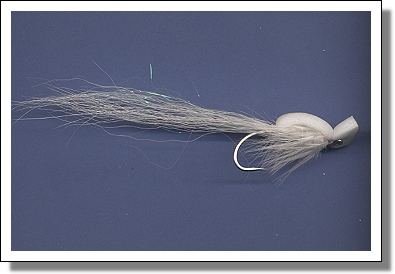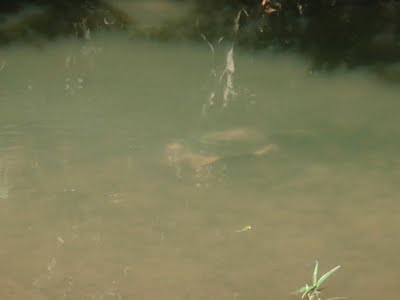It's been a little while since I've gotten out after carp. While nothing gets my heart pumping like fly casting to a tailing fish, I figured that since I have a bunch of juglines rigged up, I may as well set some out with carp bait and see what happens. Dedicated British anglers have developed complex baits based on very scientific nutritional guidelines. I don't know if "
Rob's Carp Assassin" is such a bait, but the directions read like a cookie recipe so I thought I'd give it a try.
The morning started brilliantly, right away I hooked up a beautiful fish on my version of the
carp carrot fly.

Next I paddled into a small lagoon, the
same lagoon where Tara and I had placed our juglines a few days before, and baited 8 jugs with sweet smelling dough-balls. The lagoon lies right between two good flats and I knew that carp often hang out there between meals. Having just landed a fish in one area, I left the jugs and moved on to the second flat. The carp were everywhere! Even though the wind was blowing, the morning sun penetrated the water and I could see orange tails in every direction. After missing a few, I hooked up to a medium sized fish. Some carp don't run far when they're hooked but this one took off like a rocket. It paused about 100 feet away, and then swam off in a completely different direction. Unfortunately, my leader had tangled in some algae and the direction change pulled the hook free.
I reeled my fly in and looked over my shoulder. One of the jugs was moving! In fact it was twitching violently as though something was trying to submerge it. I quickly weighed anchor and paddled over. At the entrance to the lagoon is an old submerged bridge, and as I got close I saw that indeed something was trying to pull the jug underwater and under the bridge.
I grabbed the jug and hauled it in. Hoping for a carp and expecting a turtle, I was thrilled to see I had caught a big ol'catfish:

I'm pretty sure this is a big channel catfish. Though big channel cats are hard to distinguish from blue catfish, blues often have more than 30 rays on their anal fin. This fish only has about 23:

With only 8 jugs out for less than an hour, I caught this fish on a carp bait in the middle of the morning; it makes me question some of the conventional catfishing wisdom.
 It's been a happy holiday. I fit in one day of fishing during our stay on Oahu, but what a good day it was. My friend Kirk picked me up in the morning and we headed to the south shore in search of o'io (bonefish.) The sun was shining and the trade winds were unusually quiet, good conditions for fishing.
It's been a happy holiday. I fit in one day of fishing during our stay on Oahu, but what a good day it was. My friend Kirk picked me up in the morning and we headed to the south shore in search of o'io (bonefish.) The sun was shining and the trade winds were unusually quiet, good conditions for fishing. I have fished for o'io perhaps half a dozen times in Hawaii, with very little luck. Even when the fish are all around, and the conditions are good, I can't get them to eat. I've tried fly fishing and bait fishing and I've fished all around the island. I have hooked plenty of fish, wrasses, hawkfish, cornetfish, but never a bonefish.
I have fished for o'io perhaps half a dozen times in Hawaii, with very little luck. Even when the fish are all around, and the conditions are good, I can't get them to eat. I've tried fly fishing and bait fishing and I've fished all around the island. I have hooked plenty of fish, wrasses, hawkfish, cornetfish, but never a bonefish. Most people associate bone-fishing with sight-fishing, where the angler actually sees the fish first and then casts to it. Kirk said that the sight-fishing had been spotty and suggested that we instead spend our time blind casting. Blind-casting is not really blind. Instead of looking for the fish themselves, the idea is to look for structure that might attract fish and cast near that.
Most people associate bone-fishing with sight-fishing, where the angler actually sees the fish first and then casts to it. Kirk said that the sight-fishing had been spotty and suggested that we instead spend our time blind casting. Blind-casting is not really blind. Instead of looking for the fish themselves, the idea is to look for structure that might attract fish and cast near that. Since blind-casting is more of a probability game I decided right away that my strategy would be to cast as often as possible and to fish every cast, even the bad ones. I simply figured that my chances of catching a bonefish were directly proportional to the amount of time I had my fly in the water.
Since blind-casting is more of a probability game I decided right away that my strategy would be to cast as often as possible and to fish every cast, even the bad ones. I simply figured that my chances of catching a bonefish were directly proportional to the amount of time I had my fly in the water. We saw a few tails, but the fish stayed mostly out of sight. Nevertheless, Kirk started catching fish right away. He lost the first one but soon landed another. Confident that the fish were around, and feeding, I stuck to my plan and kept casting.
We saw a few tails, but the fish stayed mostly out of sight. Nevertheless, Kirk started catching fish right away. He lost the first one but soon landed another. Confident that the fish were around, and feeding, I stuck to my plan and kept casting. Kirk was on a streak. He kept landing o'io. Determined, I made a cast into a small sandy depression and finally got a good strike! I was so excited at the prospect of catching my first bonefish that I set the hook too vigorously and pulled the poor fish clear out of the water. It was a small barracuda, fun, but not an o'io.
Kirk was on a streak. He kept landing o'io. Determined, I made a cast into a small sandy depression and finally got a good strike! I was so excited at the prospect of catching my first bonefish that I set the hook too vigorously and pulled the poor fish clear out of the water. It was a small barracuda, fun, but not an o'io. Barracuda tend to chase fast moving flies through the water, not on the bottom, so after catching this fish I switched to a bigger, heavier fly which would stay down where the bonefish feed.
Barracuda tend to chase fast moving flies through the water, not on the bottom, so after catching this fish I switched to a bigger, heavier fly which would stay down where the bonefish feed. The new fly worked well on a little wrasse, but it was even smaller than the barracuda! The tide was rising so Kirk and I made our way closer to shore, fishing as we waded. I made a cast between two small depressions and began stripping the fly back along the bottom. I felt several sharp tugs and suddenly line was flying off the reel - hana pa'a! Fish on!
The new fly worked well on a little wrasse, but it was even smaller than the barracuda! The tide was rising so Kirk and I made our way closer to shore, fishing as we waded. I made a cast between two small depressions and began stripping the fly back along the bottom. I felt several sharp tugs and suddenly line was flying off the reel - hana pa'a! Fish on! I have caught fish this size before and I wouldn't say that it took much longer to land this bonefish than it would a comparable sized carp, but after landing my first o'io I would say that, in my experience, the speed and explosive power of these fish is without peer. What a day!
I have caught fish this size before and I wouldn't say that it took much longer to land this bonefish than it would a comparable sized carp, but after landing my first o'io I would say that, in my experience, the speed and explosive power of these fish is without peer. What a day! Check out the rest of the pictures here!
Check out the rest of the pictures here!

































